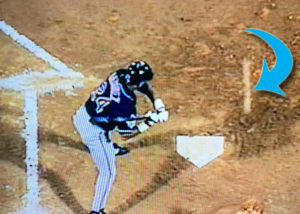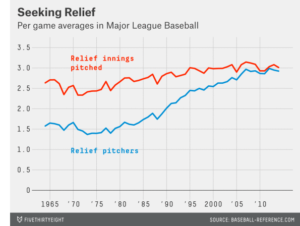WHY BASEBALL’S A DRAG
–
 –
–
The new season is just around the corner and as a fan of the game, I’m excited. I grew up playing baseball and it’s always been my favorite sport to watch, both in person and on TV. You read that right; for me, baseball trumps football… every time.
Even though I’m a fan, and a big fan as my confession above would so indicate, I think watching a baseball game these days is somewhat painful. I still watch it, but I don’t enjoy it nearly as much and I’m trying to figure out why.
I always loved playing the game. I played from the first moment Little League provided me a jersey and ball cap at age 6 until I finally had to give up playing co-ed softball in my early 50’s due to my deteriorating eyesight. I loved every minute of it and cherish more memories than I could possibly count from days gone by. Thank you baseball; thank you!
I think one of the reasons those who played the game love to watch the game is that, even at baseball’s highest level (the major leagues) we can relate to the action on the field. Who among us doesn’t believe we could still easily drift under a fly ball, or leg out a liner in the gap and slide into second with a standup double? Oh, what a transcendent thrill that will never leave my soul!
As we watch the game on TV, I still pause the action from time to time to explain little nuances to my wife. She’s taken to the game, even though she never played and she actually enjoys watching both at home and at the park. I’m a lifelong Cardinals fan and she’s become one through association. Remind me to tell you the Albert Pujols to the Angels story one day; it’s funny, but it doesn’t really fit in this blog entry.
So, if I love the game, why has it become such a drag, even to me? I pondered the question this morning over a fresh cup of coffee. What else was really begging to be done at 5am?
In the picture featured above, you might notice a white streak just off the plate. That’s the ball, just before it reached the catcher’s mitt. The pitch was thrown to Manny Ramirez by Greg Maddux in the 1995 World Series Game 1 and it was called, “Strike Three” by the home plate umpire, Harry Wendelstedt. Manny went 0 for 3 that day and Maddux struck out 4. The Braves beat the Indians 3 to 2 in just 2 hours and 37 minutes. (Box Score)
By comparison, the first game of last year’s World Series between the Astros and Dodgers took 2 hours and 28 minutes. (Box Score) What??? Really??? I thought the game had slowed down? I thought “Pace of Play” had become a nuclear issue between players and the Commissioner’s office? Those numbers just can’t be right, but they are. I double-checked ’em and provided you the links, just in case you want to do your own follow-up.
As Billy Chapel said to Mr. Wheeler,
“The game doesn’t stink, Mr. Wheeler. It’s a great game.”
–
Having seen the picture, pictured above, in a video clip, my first thought was that the game moved at a quicker pace back then because the strike zone was bigger and hitters were more aggressive. Today’s game drags, because hitters are just taking too many pitches, looking for a fat one that they can hit into the seats. A little research proved my perception to be askew. In 1995, the league average was 145.3 pitches per game; in 2017, that number has increased by a whopping 3 pitches. That hardly seems to be a supportive statistic.
My second thought was that today’s game sees too many pitching changes. I still think that this groundbreaking insight has some merit, but again the stats seem to indicate that it’s not nearly as big a difference as I had imagined. The graph to the right, provided by 538 dot-com, shows that from 1995 to last year, the increase has only equated to about one-half of a pitcher per game and the increase has been gradual, not a drastic climb over the last five seasons.
that this groundbreaking insight has some merit, but again the stats seem to indicate that it’s not nearly as big a difference as I had imagined. The graph to the right, provided by 538 dot-com, shows that from 1995 to last year, the increase has only equated to about one-half of a pitcher per game and the increase has been gradual, not a drastic climb over the last five seasons.
Although the stats aren’t nearly as alarming as I’d envisioned, I’m still convinced that the pitching change rule needs some refining. In my mind, if a manager makes a pitching change during an inning, that pitcher should stay on the mound as long as he’s getting batters out. If he allows the other team to put runners on base, then the manager can go get a fresh arm, but if he just threw 3 pitches and got the batter to pop up to third, I don’t want to see the manager going back to the bullpen for another fresh arm. That kinda stuff just grinds my gears and makes me want to pull out a slingshot and pelt the manager with frozen peas. (For the record, don’t try that at home; it’s not good for the TV. Oh, and they won’t let you do it at the ballpark. I’m guessing, not speaking from experience, just in case you’re wondering.)
The bottom line is this: the league has been trying to pin “pace of play” issues on the backs of the players for the last five seasons or so and the data shows that the players are still playing the game with the same giddy-up in their get-a-long. Get off their backs already. The game doesn’t stink, Mr. Wheeler. It’s a still a great game.
So, what’s changed? I suspect there are two culprits. One, I’m certain we can convict and the other would most likely rather settle out of court than let the decision go to a jury.
Every single game is televised these days. That wasn’t the case in 1995. I’m suspicious of the amount of time given to commercial breaks. In a 9 inning game, we’ve got at least 18 scheduled breaks to sit through, plus the extra 4 to 6 for pitching changes. Add another 3 or 4 that get worked into every pregame show and we’re approaching 30 commercial breaks per game. If those breaks are even 5 seconds longer on average, we’ve added an extra 2½ minutes to every game. If they’re 10 seconds longer, we’ve added 5 minutes and if we just slide in one extra 20 second spot for each break, we’re at the 10 minute mark. This is starting to add up, especially when you consider that the average length of an MLB game back in 1995 was 2 hours and 50 minutes and in 2015 it had ballooned to a whopping 2:56. That’s right… only a 6 minute difference over 20 years, but I still think we can pin at least a little bit of that difference on television broadcasts.
Since 2015 however, that number had increased substantially. In the last two seasons, the average length of game has grown to 3 hours and 5 minutes. I don’t think we can pin that on commercials and the statistics show that it’s not the players or the managers doing either. This one is an open and shut case, your honor. Over the last 2 seasons, replay of close calls throughout the game has gotten way too invasive.
I’m all for getting a call correct if an egregious error has been made. I want to see the team that has earned the win actually get the win. I’m a Cardinals fan, after all, and I still believe that Don Denkinger’s mind-boggling gaff on an out/safe call at first base cost the Cardinals the 1985 World Series. I also hated seeing umpire Jim Joyce blow a similar call at first base that cost Detroit Tigers’ pitcher Armando Galarraga a Perfect Game in the Summer of 2010. That’s one of MLB’s Infinity Stones, people. I’m a fan of the game and my heart just hurt over that one. Joyce knew that he had blown the call and there was no means by which the game allowed the wrong to be righted, even though Joyce would have been the first to step up and ask that the call he made in the heat of the moment be changed.
All of that being said, I still want the umpires to be a part of the game at the core level and I don’t want every close call reviewed frame by frame, as has become the trend. If the call is obviously wrong, change it. Pop the image on the jumbo tron for the entire stadium to see and follow it with a short text that states the correction. We have the technology to do that. The umpires don’t need to huddle. The managers don’t need to come out of the dugout and hold up a finger, asking for play to be put on hold while someone looks at whether a player’s foot popped off of the bag by a fraction of an inch at the tail end of his slide. Just fix the stuff that is clearly wrong and move along.
If you need to get creative to hold the fans’ attention, put that little buffering wheel up on the Diamond Vision scoreboard, but give me a resolution image within 10 to 12 seconds and quit holding the game prisoner. It’s out of control and it, just like this blog post, needs to stop. It’s Saturday. I shouldn’t get this flustergabbered. Let the record show that I don’t always write about sports, but I do enjoy sports and I always write about the things I enjoy. Batter up. Play ball.
–
Quick Links to Mark’s Books on Amazon:
| PUSH Mark D. Combs |
Don’t Forget Your Cape Mark D. Combs |
HELLO… IS THIS ON? Mark D. Combs |
–


